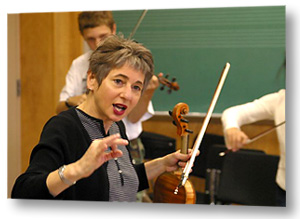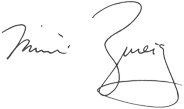
Mimi Zweig is currently professor of violin at the Jacobs School of Music and director of the Indiana University String Academy.
| A Letter from Mimi |  Mimi Zweig is currently professor of violin at the Jacobs School of Music and director of the Indiana University String Academy. |
Dear Teachers, Students, and Parents:
I would like to give you a brief background on where I came from and how my teaching ideas have evolved since 1972 when I began teaching children as an assistant teacher with Nancy Kredel at the North Carolina School of the Arts.
My teaching is an amalgamation of the many different influences on my life. I see myself as a giant sponge who has been able to absorb information from the people who have influenced and enriched my life. In all honesty, I cannot say that I am "original". It is the piecing together of information that has come from teachers, from observing master classes, and from my own teaching experiences by trial and error. These have combined to give me an understanding of problem solving and to continue growing musically. As a teacher, one needs to develop that sixth sense of knowing what students need and when to give them this information. The road young people traverse in order to play the violin is fascinating to me. Their violinistic and musical progress continues to inspire me to search for excellence in teaching.
My earliest years of violin playing (I began at the age of 8) were filled with musical inspiration but did not give me the technical foundation and physical understanding that I would like my students to have. Probably because of this, I became very conscious of what it takes to play the violin well. My first inspirational teacher was Louis Krasner (Syracuse University) who made me aware of the beauty of the violin and the possibilities of playing artistically. Raphael Bronstein (Manhattan School of Music) introduced me to the wide range of violin repertoire. Samuel Kissel (a student of Dounis) gave me the vocabulary to understand how to play the violin. In 1972 I brought home the 14 films of Paul Rolland ("The Teaching of Action in String Playing") and watched them continuously for four days. That is when I began to understand the rudiments of violin technique and how it applies to early training. This work continued with Tadeusz Wronski at Indiana University who structured my approach to rehabilitation as he put me through his system using the Kreutzer Etudes. At this point, my basic technical structure was falling into place, and the information I subsequently absorbed could more easily be understood and applied. Janos Starker gave a week of significant master classes that added specific information to this structure. Finally, the memories of Josef Gingold's teaching are in my mind every day as I suggest fingerings, bowings, shifts, slides, or how to play a specific phrase.
All of this knowledge is only half the battle. The other half is to create a non-judgmental environment of learning in the studio, practice room and concert hall. Jerry Horner studied the principles of The Inner Game of Tennis by Timothy Gallwey, applied them to his playing and teaching, and introduced me to Gallwey's concepts in the mid-70's. As performers (whether musicians or athletes), we are always searching for the state of mind that allows us to deal with mistakes, recognize them, not as good or bad, but simply as information, and then through discerning repetitions allow the mistakes to be corrected. This approach to practicing and performing gives the performer freedom of expression and technical confidence on a consistent basis.
Teachers are often like diagnosticians. If we can identify the problem, we can probably come up with the cure. The key is breaking down the problem to the simplest level and then giving the student the information to solve the problem. In reality, problems occur between two notes and it becomes "just" a matter of identifying the specific two notes.
Students need to take ownership of their playing; progress needs to become their responsibility. When students arrive at this realization, the progress that they make is the true reward and inspiration to continue the search for beautiful playing. As teachers, we can give the correct information, but the students' growth is directly proportionate to the investment of their time and effort.
As we know, playing the violin is a lifelong journey for the teacher and student. Our goal is for students to become their own teachers. When students reach this level, we teachers feel a great sense of accomplishment. Teaching and playing the violin become a way of life that is filled with adventure, fascination and hard work. Success lies in the joy of a good journey.
It
is my hope that your musical journey will be enhanced by a ride through
StringPedagogy.
Best wishes,

Mimi Zweig
I would like to thank
Indiana
University Jacobs School of Music for giving me the opportunity to develop my teaching in an
environment of continuous support,
my students and colleagues for all we have accomplished together:
Brenda Brenner for our continual search for excellence in teaching at the Jacobs School of Music,
Rebecca Henry, James Przygocki, and Sherry Sinift for the contributions in collaborating on the development of materials in StringPedagogy over the past 30 plus years,
Chih-Yi Chen for her piano playing and coaching which pushes our students to the next level,
All the students and fellow teachers who have helped shape this pedagogy
the
people directly involved in creating StringPedagogy:
Amy Lidell, Claire Kim, and Sophie Young for their playing in Volume One,
Rachel Auer, Rachel Patrick, Robin Scott, Laura Reid, Robin Braun and Sangwoo Kim for their playing in Volume Two,
String Academy students for their Group Lesson playing,
Zoe Hightower for her beautiful violin position on the StringPedagogy photo,
Rachel Patrick for her violin position photos,
Rachelle Berthelsen for organizing the original pedagogy document,
Jamie Hofman for his website help,
Bonnie Greene and One World Strings for the music,
Peggy Wheeler for her help in editing StringPedagogy and always pushing me to the next level of explanation,
Hideki Isoda for his expertise, knowledge and guidance into the world of technology,
and most of all,
to my father who kept encouraging me to write a book on violin playing but is not alive to see this, and
to my mother for her love and support over the many years of my life.